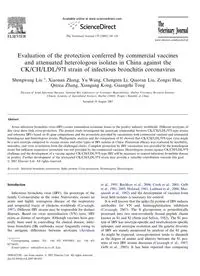
2009 Evaluation of the protection conferred by commercial vaccines and attenuated heterologous isolates in China against PDF
Preview 2009 Evaluation of the protection conferred by commercial vaccines and attenuated heterologous isolates in China against
Evaluation of the protection conferred by commercial vaccines and attenuated heterologous isolates in China against the CK/CH/LDL/97I strain of infectious bronchitis coronavirus Shengwang Liu *, Xiaonan Zhang, Yu Wang, Chengren Li, Qiaoran Liu, Zongxi Han, Qinxia Zhang, Xiangang Kong, Guangzhi Tong Division of Avian Infectious Diseases, National Key Laboratory of Veterinary Biotechnology, Harbin Veterinary Research Institute, Chinese Academy of Agricultural Sciences, Harbin 150001, People’s Republic of China Accepted 18 August 2007 Abstract Avian infectious bronchitis virus (IBV) causes tremendous economic losses to the poultry industry worldwide. Different serotypes of this virus show little cross-protection. The present study investigated the genotypic relationship between CK/CH/LDL/97I-type strains and reference IBVs based on S1 gene comparisons and the protection provided by vaccination with commercial vaccines and attenuated homologous and heterologous strains. Phylogenetic analysis and the comparison of S1 showed that CK/CH/LDL/97I-type virus might be a new serotype compared to vaccine strains and other types of IBV isolates in China. Protection efficacy was evaluated by morbidity, mortality, and virus re-isolation from the challenged chicks. Complete protection by IBV vaccination was provided by the homologous strain but sufficient respiratory protection was not provided by the commercial vaccines. Heterologous strains against CK/CH/LDL/97I challenge and the development of a vaccine against CK/CH/LDL/97I-type IBV will be necessary to control infectious bronchitis disease in poultry. Further development of the attenuated CK/CH/LDL/97I strain may provide a valuable contribution towards this goal. � 2007 Elsevier Ltd. All rights reserved. Keywords: Infection bronchitis coronavirus; Spike protein; Cross-protection; Homologous; Heterologous Introduction Infectious bronchitis virus (IBV), the prototype of the family Coronaviridae in the order Nidovirales, causes an acute and highly contagious disease of the respiratory and urogenital tracts of chickens worldwide (Cavanagh, 1997). Different IBV strains may be responsible for distinct illnesses. Based on virus neutralisation (VN) tests, IBV exists as dozens of serotypes. Although vaccines have gen- erally been used in controlling the clinical disease, infec- tious bronchitis (IB) outbreaks occur frequently owing to the antigenic differences between serotypes (Arvidson et al., 1991; Bochkov et al., 2006; Cook et al., 2001; Gelb et al., 1981, 2005; Hofstad, 1981; Ladman et al., 2006; Mar- quardt et al., 1982) and the development of vaccines from local field isolates is necessary for control. It is well known that the spike (S) protein of IBV induces antibodies for VN and haemagglutination inhibition (Cavanagh, 2007). The S glycoprotein is proteolitically processed into two non-covalently bound peptide chains known as S1 and S2 (Stein and Sefton, 1982). The S1 pro- tein of IBV has serotype-specific and neutralisation-specific epitopes, and serotypic evolution and the genetic diversity of IBV are mainly monitored by analysis of the S1 gene. As might be expected, cross-protection tends to diminish as the degree of amino acid identity between the S1 pro- teins of two IBV strains decreases (Cavanagh et al., 1997; Gelb et al., 2005). It has been reported that comparing 1090-0233/$ - see front matter � 2007 Elsevier Ltd. All rights reserved. doi:10.1016/j.tvjl.2007.08.018 * Corresponding author. Tel.: +86 451 85935065; fax: +86 451 82734181. E-mail address:
